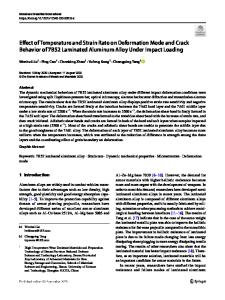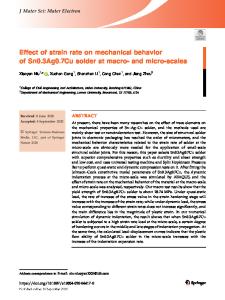Effect of Test Temperature and Strain Rate on Dynamic Mechanical Behavior of Aluminum Alloy 2519A
- PDF / 3,298,022 Bytes
- 8 Pages / 593.972 x 792 pts Page_size
- 102 Downloads / 337 Views
JMEPEG https://doi.org/10.1007/s11665-019-04216-7
Effect of Test Temperature and Strain Rate on Dynamic Mechanical Behavior of Aluminum Alloy 2519A Ling-ying Ye, Yu Dong, Yong Zhang, Da-xiang Sun, and Xin-ming Zhang (Submitted October 15, 2018; in revised form May 16, 2019) The dynamic mechanical behavior of aluminum alloy 2519A-T9I6 has been investigated by a split Hopkinson bar at temperature range from 298 to 523 K and at strain rates of from 103 to 5 3 103 s21 in this study. The results show that both the strain rate and test temperature have a significant effect on the dynamic behavior and microstructure evolution of aluminum alloy 2519A-T9I6. Under similar strain rate, the strengthening effect of strain rate decreases with the increase in the test temperature. Moreover, the dynamic yield strength at above 423 K drops sharply at the strain rate of about 5000 s21, which is attributed to the flow softening caused by decomposition of h¢ precipitates at high strain rate and high temperature. Keywords
2519A, decomposition of h¢ precipitates, dynamic yield strength, high stain rate, split Hopkinson bar
1. Introduction An age-hardenable aluminum alloy named 2519A alloy has been widely used in military applications. For some specific applications, such as ballistic armors, the dynamic mechanical properties should be concerned as the materials may experience rapid change in temperature and strain in a very short time (less than 100 ls) during the dynamic impact (Ref 1-3). Although constitutive equation of 2519A alloy involving test temperature and strain rate has been established, systematic observation of the evolution of microstructure during dynamic impacting still needs to be made. For the structure design of real ballistic applications, it is of great importance to characterize the effects of test temperature and strain rate on the dynamic behavior of 2519A alloy, as well as its microstructure evolution. Although most structure materials demonstrate a different response when increasing test temperatures or strain rates, yet higher dynamic mechanical properties do associate with higher general mechanical properties. Gu and his co-workers have demonstrated that the strength of alloy 2519A can be further improved by interrupted aging process (Ref 4-6). The interrupted aging process named ‘‘T9I6’’ (solution treatment, quenching, pre-aging, pre-deformation, interrupted aging and reaging) could reduce the average size of the strengthening phase and increase its volume fraction in 2519A alloy, which is
Ling-ying Ye, Yu Dong, Yong Zhang, and Xin-ming Zhang, School of Materials Science and Engineering, Central South University, Changsha 410083, China; Da-xiang Sun, Guangdong Industry Analysis Testing Center, Guangzhou 510650, China. Contact e-mail: [email protected].
Journal of Materials Engineering and Performance
beneficial to both its mechanical properties and dynamic impact resistance. According to Gu, the maximum tensile strength of 2519A alloy can reach 540.1 MPa, while the elongation can reach 14.3% (Ref 4). A
Data Loading...











